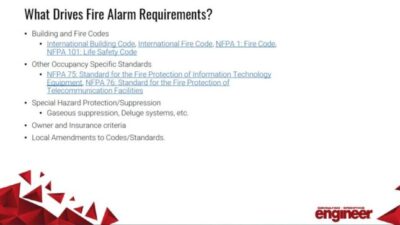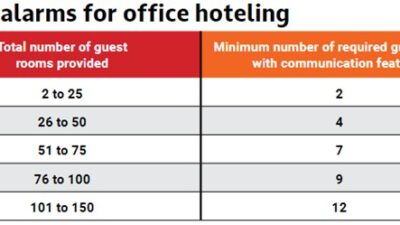Egress and life safety have come to the forefront of the news, as two deadly nightclub disasters within four days of each other last month resulted in a death toll of more than a hundred people. On Sunday, Feb. 16, 21 were killed in a stampede of patrons trying to escape the E2 nightclub in Chicago.
Egress and life safety have come to the forefront of the news, as two deadly nightclub disasters within four days of each other last month resulted in a death toll of more than a hundred people.
On Sunday, Feb. 16, 21 were killed in a stampede of patrons trying to escape the E2 nightclub in Chicago. That same week, a fire consumed The Station nightclub in West Warwick, R.I., resulting in 98 deaths.
The loss of life in both incidents resulted from questionable, if not illegal, practices by both venues’ staff. In Chicago, a club employee reportedly sprayed pepper spray into the crowd—estimated to be between 400 and 1,500—to break up a fight. As patrons—some of whom indicated they believed they were experiencing a terrorist biological attack—rushed down the stairs to the main entrance, many fell and were trampled or crushed against the front doors, which were blocked. In West Warwick, a code-prohibited pyrotechnical display ignited exposed soundproofing, sending the fire across the building in a matter of seconds.
But there is much more behind both disasters, say experts in the fire-protection and life-safety industry—things that could have prevented such a high death toll. “In incidents like this, it’s usually not just one thing that goes wrong, it’s three or four things going wrong at the same time that result in these major disasters,” says Tom Jaeger, president of fire-safety consultant Gage-Babcock and Assocs., Chantilly, Va., adding that while thousands of fires occur every year in the United States, not many result in the loss of life that occurred in February’s incidents.
Adding to the problem at E2, he says, was the fact that the alternate exits weren’t easily accessible to the club’s patrons. But even if they had been, people wouldn’t have necessarily used them. “One of the biggest dangers of an assembly occupancy is that the building is filled with people who are not familiar with the physical features of the building they’re in,” Jaeger explains. “It’s human nature for occupants not familiar with a building to try to exit where they entered.”
Combine these issues with alcohol, he says, and the likelihood of disaster increases even more.
Exiting issues were also cited in the West Warwick fire, where the patrons weren’t aware of alternate exits and all attempted to leave through the main entrance. The major culprit in this case was the pyrotechnical display, but it was fueled literally and figuratively by specific circumstances, one of which was the fact that it shouldn’t have been allowed in the first place. “The codes all clearly say that you can’t have pyrotechnics without the inspection and approval of the local fire authority, and that was clearly not obtained,” Jaeger says. In addition, the walls and ceiling were lined with a highly flammable soundproofing material that facilitated the incredible rate at which the fire spread.
“I understand what they’re trying to accomplish with soundproofing, but did anyone look at it from a flame spread standpoint?” asks Jerry Schulz, president of the Downers Grove, Ill., office of Fire Protection International. In regard to exiting, he suggests that while codes already address human behavior in fires, perhaps they should be re-addressed. He points out that in any assembly area, the main entrance is required to be sized to handle 50% of the facility’s occupants. Unfortunately, he points out, codes are often written or updated because of tragic events. “There are lessons to be learned from any fire,” he says. “This one might make us ask if it’s time to look [again] at exiting in a night club, lounge or that type of environment.” Schultz also stresses the importance of sprinklers, an issue that would have been irrelevant at E2, but may have prevented deaths at The Station, where none were installed.
Tom Miller, president of the Oak Brook, Ill., office of fire protection consultant Varley-Campbell and Assocs., points out that the maximum occupancy at E2 was clearly surpassed. “You can only put so many bodies in a space before they become upset,” he says.
Incidents such as those at E2 and The Station, however tragic, can offer lessons on improving the safety of club patrons. “If there’s such a thing as a positive within the Rhode Island nightclub fire, it’s that this is the first major fire loss which is on film,” Jaeger says. “There will be a lot to be learned from that film.”
He suggests that perhaps better enforcement is one answer. “If you really look at both [incidents], there’s a real need for better enforcement,” he says. “I’m not being critical of the enforcement authorities; I suspect that in today’s budgetary cuts, many of the enforcement authorities don’t have the resources to do that much enforcement. And I don’t fault the enforcement authorities for the pyrotechnics. If they weren’t asked to issue a permit, they wouldn’t know about it.” He also suggested that surprise inspections could yield many violations involving locked and blocked doors. The weekend after the E2 incident, Chicago authorities reportedly visited several nightclubs for just that reason.
Miller suggests that patrons should be aware of nearby exits. “If you’re in a large assembly room, whether it’s a hotel assembly room or a night club, from where you’re seated or close to where you’re seated, you should see one, if not two, exit signs,” he comments. “If you don’t, I wouldn’t come back to the place again.”



